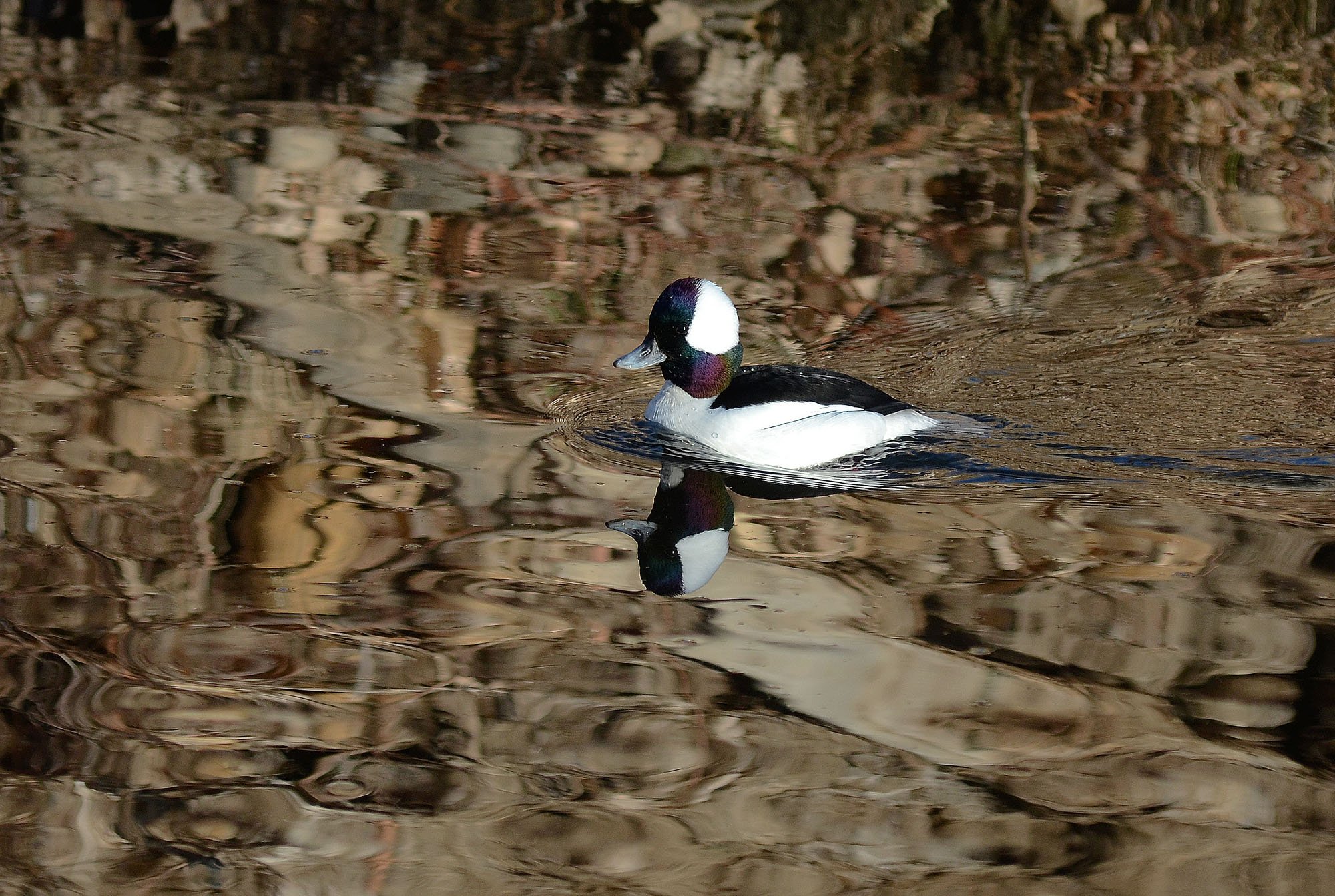Nature Almanac: Tiny Divers. . . Buffleheads!
by Scott Severs, with Stephen Jones and Ruth Carol Cushman
October 2023
As temperatures drop and frosty mornings become routine, new varieties of handsome waterfowl descend upon the ponds and lakes of eastern Colorado. Included in this group is the tiny Bufflehead duck. Many will stay here as long as the water remains free of ice, diving and feeding on small fish and on the aquatic plants that remain from the summer past. Leaving the cold northland behind, Buffleheads find favorable wintering grounds near open water and in sheltered bays along both coasts.
Female (left) and male (right) Bufflehead pair. Photo by Steve Jones
The male Bufflehead shows bold black-and-white patterning. He has a puffy, oversized black head (supposedly resembling the head of a bison), with a large snowy white patch at the back. In good light, the black on the head shows iridescent shades of purple and green. In the air, males whir across the water with a flash of black-and-white wings. Softer tones of brown color the female, and a small white patch graces her cheek behind the eye.
Most Buffleheads nest along the edges of ponds or lakes in Canadian woodlands. Each summer, they hatch broods of six to ten little ducklings in abandoned flicker cavities in old trees. Females incubate the eggs in the bottom of the hollow for about a month. Once they hatch, the ducklings stay another day or two until the female persuades them to plop down to the ground and follow her to water. In another couple of months, the young will be able to fly, just in time for the journey south.
Female Bufflehead about to take off. Others of her flock have already departed. Photo by Steve Jones.
Unlike Mallards and other surface-feeding ducks, Buffleheads (and their close relatives -- goldeneyes and scoters) dive for their food. They eat small crustaceans, such as shrimp and other invertebrates. Buffleheads post guards when submerging for food. While members of the flock (usually five to ten individuals) go under, one bird remains above to watch for danger. Buffleheads often fall prey to Bald Eagles, and because of their small size, they must endure the attacks of gulls. I once watched a Great Black-backed Gull pluck a Bufflehead off the surface of the water along the shores of Connecticut. The unfortunate duck made frantic attempts to get away but was carried off by the powerful gull.
In 1987, a small group of nesting Buffleheads turned up in northern Colorado, in western Jackson County, nearly 500 miles south of the traditional summer range of the species! Estimates show there may now be 50 to 100 pairs. Andrews and Righter in Colorado Birds state: "it is unknown whether this breeding population has always been present or is a recent phenomenon." It's exciting to think that Colorado has appropriate habitat for these little ducks. In Colorado, they nest near beaver ponds in old growth aspen woodlands.
Bufflehead breeding locations in Colorado. Map from the Colorado Breeding Bird Atlas II.
Most of us don't see Buffleheads until winter. Look for them in lakes and ponds, especially in parks and refuges free from disturbance. Boulder and Baseline Reservoirs in eastern Boulder County make for easy local viewing.
Male Bufflehead. Photo by Steve Jones.
Other October Events
An annular solar eclipse arrives on October 14! In Boulder, it will be only a partial eclipse, but look for it in near totality around the Four Corners and northwest New Mexico. An annular solar eclipse differs from a total solar eclipse because the moon doesn’t cover the entire surface of the sun, producing a bright “ring of fire” around the edge of the moon. (A total solar eclipse is coming to the US in April 2024). Excellent details can be found online at skyandtelescope.org
Sandhill cranes stream through on migration, often so high all that can be detected loud trumpeting calls between each other as flocks pass overhead.
Fall colors peak in town. Check out the tree tour of Longmont trees here: Longmont Tree Tour (a GIS map story).
Great Horned Owls begin courtship. Listen for duetting owls, males with the deeper “Whoooo’s Awake? Me too!” if put to words.




